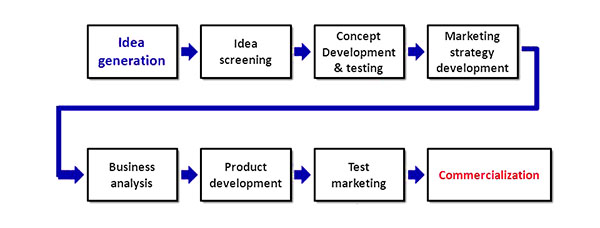Developing a new product shouldn’t feel like you’re fighting in the dark. There’s an easier way. What you need is a structured road-map that gives your business a clear path to follow.
Actually developing the tangible product or service is only a small part of the new product development process, which includes the complete journey of generating the initial idea to bringing the product to market.
By setting out the steps involved, and sticking to them, your product development will become a more focused and flexible approach that can be adapted for all different types of products and services.

Product Development Process
Idea Generation
The development of a product will start with the concept. The rest of the process will ensure that ideas are tested for their viability, so in the beginning, all ideas are good ideas (To a certain extent!) ‘
Ideas can and will come, from many different directions. The best place to start is with a SWOT analysis, (Strengths, Weaknesses, Opportunities, and Threats), which. incorporates current market trends. This can be used to analyze your company s position and find a direction that is in line with your business strategy.
In addition to this business-centered activity, are methods that focus, on the customer’s needs and wants This could be:
- Undertaking market research
- Listening to suggestions from your target-audience — including feedback on your current products’ strengths and weaknesses.
- Encouraging suggestions from employees and partners
- Looking at your competitor’s successes and failures
Idea Screening
This step is crucial to ensure that unsuitable ideas, for whatever reason, are rejected as soon as possible. Ideas need to be considered objectively, ideally by a group or committee.
Specific screening criteria need to be set for this stage, looking at ROI, affordability and market potential. These questions need to be considered carefully, to avoid product failure after considerable investment down the line.
Recommended for YouWebcast: Advanced Facebook Growth Hacking
Concept Development & Testing
You have an idea and it’s passed the screening stage. However, internal opinion isn’t the most important. You need to ask the people that matter — your customers.
Using a small group of your true customer base — those that convert — the idea needs to be tested to see their reaction. The idea should now be a concept, with enough in-depth information that the consumer can visualize it.
Do they understand the concept?
Do they want or need it?
This stage gives you a chance to develop the concept further, considering their feedback, but also to start thinking about what your marketing message will be.
Business Analysis
Once the concept has been tested and finalized, a business case needs to be put together to assess whether the new product/service will be profitable. This should include a detailed marketing strategy, highlighting the target market, product positioning and the marketing mix that will be used.
This analysis needs to include: whether there is a demand for the product, a full appraisal Of the costs, competition and identification of a break-even point.
Product Development
If the new product is approved, it will be passed to the technical and marketing development stage. This is when a prototype or a limited Production model will be created, This means you can investigate exact design & specifications and any manufacturing methods, but also gives something tangible for consumer testing, for feedback on specifics like a look, feel and packaging for example.
Test Marketing
Test marketing (or market testing) is different to a concept or consumer testing, in that it introduces the prototype product following the proposed marketing plan as whole rather than individual elements.
This process is.required to validate the whole concept and is used for further refinement of all elements, from product to marketing message.
Commercialisation
When the concept has been developed and tested, final decisions need to be made to move the product to its launch into the market. Pricing and marketing plans need to be finalized and the sales teams and distribution briefed so that the product and company are ready for the final stage.
Launch
A detailed launch plan is needed for this stage to run smoothly and to have maximum impact. It should include decisions surrounding when and where to launch to target your primary consumer group. Finally, in order to learn from any mistakes made, a review of the market performance is needed to access the success of the project.












